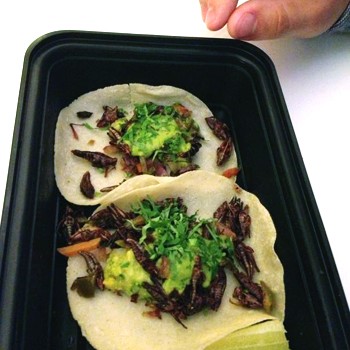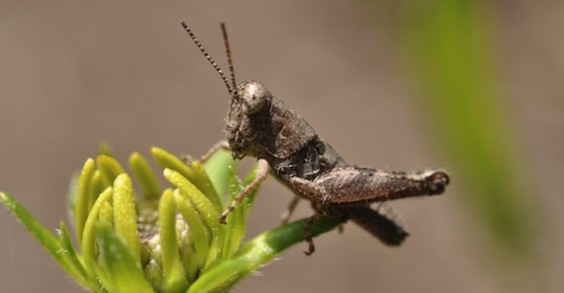They’re creepy, they’re crawly, and they’re most definitely not welcome in our closets and cupboards. But on our dinner plates? That’s a whole different story. A new UN report says humans could become increasingly reliant on insect protein for nourishment. But before mourning the loss of civilized cuisine, we examined why eating bugs could be the next great thing in food — and indulged in a six-legged taste test.
You Want Flies With That? — What It Is
Population scientists generally agree the Earth will be home to roughly 9 billion people by 2050. The recent UN report comes as researchers and governments search for answers on how to feed our next great baby boom. Some estimates indicate we’ll need to double food production just to keep up with demand. One of the biggest challenges for future food producers revolves around protein.
As The Economist illustrates in a nifty series of graphs, current sources of animal protein — especially in livestock-reliant Western countries — are pretty inefficient when it comes to converting animal feed to human food. (For example, it takes a full 8 kilograms of feed to grow a single kilogram of beef.)
That spells trouble for humans and the environment. As we’ve written about before, raising insects requires significantly less water, waste, and space than most of our current go-to meat sources
((An exploration on greenhouse gas and ammonia production by insect species suitable for animal or human consumption. Oonincx, D.G., van Itterbeeck, J., Heetkamp, M.J., et al. Laboratory of Entomology, Department of Plant Sciences, Wageningen University, Wageningen, The Netherlands. PLoS One 2010;5(12):e14445.)). Insects can also be downright healthy, high in nutrients like iron and vitamin B on top of their top-notch protein. So, on a planet where environmental and food resources are already stretched thin, population growth necessitates some radical new thinking.
That’s why the UN report, published May 13, is such a fascinating read for foodies (even despite its prodigious, 187-page length): It’s a logical call to arms for eaters worldwide, complete with suggested action plans and current successes in the world of "entomophagy," a fancy term for the eating of insects. From Europe to Asia, companies are already developing efficient, clean methods of producing edible bugs, though much of what gets hatched currently goes toward fish food. (Eating insects isn‘t new for non-Westerners, cultures all over the globe have been enjoying creepy crunchies since the dawn of time.) ((Potential of Insects as Food and Feed in Assuring Food Security. van Huis, A. Laboratory of Entomology, Wageningen University, 6700 EH Wageningen, The Netherlands. Annual Review of Entomology.))
Given a big enough economic impetus — perhaps an impending global food crisis — a huge market could emerge to breed bugs as high in flavor as they are in energy. And that means we might not be far off from crickets, mealworms, and even cockroaches hitting dinner plates everywhere.
Grasshopper Tacos — The Taste Test
Of course, it’s one thing to postulate about the future of food; we had to put our bugs where our mouths were. That meant a trip to Toloache, an eatery in midtown NYC known for their margaritas and, uhm, grasshopper tacos. One takeout order of the "chapulines" — which the server assured me were freshly pan fried — and I was back to Greatist HQ, ready for my inaugural insect meal.

I couldn’t help but feel an inherent twinge of hesitation before I took the first bite, and I worried my (largely senseless) American sensibilities could get the better of me.
That aversion isn’t entirely without merit, as most people who grow up in the U.S. aren’t first exposed to insects under sanitary conditions. But while popping non food-grade arthropods in our mouths isn’t the best idea, I reminded myself that it wasn’t all that different in principal than eating related exo-skeletal treats like lobster or crab. (I could see seafood aficionados as the first to adopt an insect-heavy diet.)
Another possible and momentary aversion was the vast number of individual organisms I was about to eat in one sitting. And if tacos full of grasshoppers are bad, imagine how many mealworms would go into an imitation beef patty. But as someone who’s enjoyed plenty of hamburgers over the last decade, I’m already used to sampling from potentially hundreds of animals per bite.
With no excuses left, I took the plunge, along with a few other brave greatists who lurked too close to lunchtime. The verdict? Not bad, with an aftertaste like roasted nuts and lemongrass. While they won’t be replacing my favorite taco fillings anytime soon, the grasshoppers provided a nice salty crunch that worked especially well with guacamole. The other tasters echoed my sentiments, though we couldn’t agree on exactly what they tasted like beyond salsa verde (which they happened to be cooked in).
That illustrates a key point in modern cuisine that should give picky eaters some solace: At the end of the day — and in an age of both international seasonings and chemical flavor enhancements — insects will probably end up tasting however we want them to taste. Texture might be a tougher obstacle, as it is for almost all imitation meat. But it’s surely not an impossible issue to overcome, and hey, the grasshoppers I tested already lend themselves to crunchy, bagged snacks. So while eating insects will undoubtedly take some getting used to for Westerners, the question will inevitably shift from “Why do I have to eat bugs?” to “Are these crickets free range?”
Would you eat insects as a primary food source? Sound off below


No comments:
Post a Comment